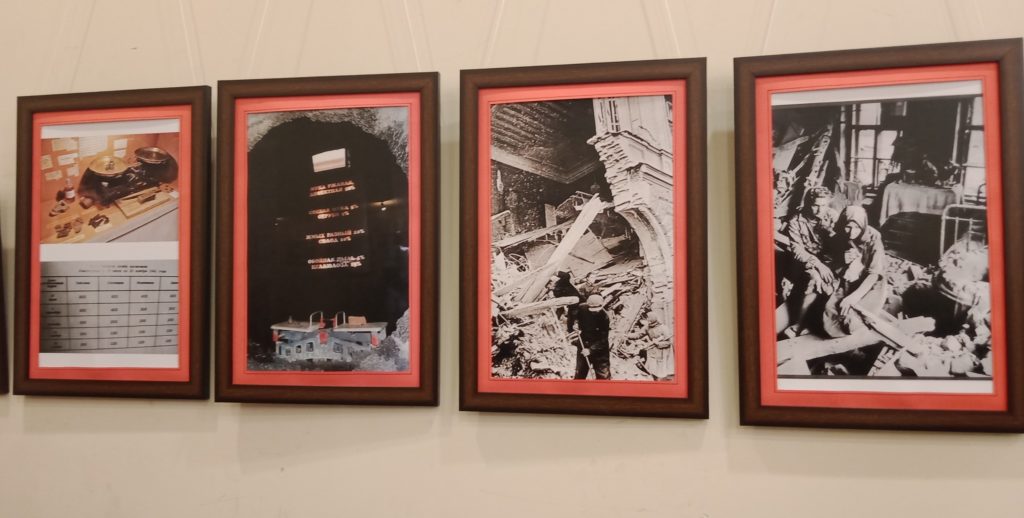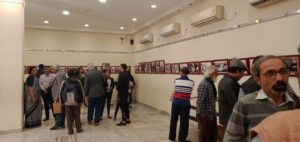Remembering the Siege of Leningrad
The siege of Leningrad stands testament to both the evil and the heroism that humankind has been capable of unleashing.

On 27th January 2020 the world marked a momentous event – the 76th anniversary of the end of the siege of Leningrad. Going down in history as one of the most excruciating eras in modern human history the siege of Leningrad stands testament to both the evil and the heroism that humankind has been capable of unleashing. It also marked a pivotal moment in the Second World War, changing the course of the war itself, in favour of the Allied Forces.
In Kolkata the Russian Centre for Science and Culture organised an exhibitions of photographs and memorabilia depicting the siege. Visitors were given a tour into history by Vladimir Deementev, the Director of the Centre, who recalled the pathos, the pain, and the valor of the city’s residents, while personally guiding the visitors to each exhibit.
Germany invades USSR
ON 22 June 1941 Nazi Germany invaded the Soviet Union. More than 180 divisions, 3 army battalions, 3 air fleet and a fleet of the Nazi navy (a total 5.5 million people) attacked the territory of the USSR from North to South over a territory of length of 4,500 km. As a result, 5 Soviet republics were occupied by Germany: Belarus, Ukraine, Estonia, Latvia, Lithuania and 13 regions of Russia. The main targets of the German troops were Moscow, Leningrad, Stalingrad.
Adolf Hitler’s directive of September 22, 1941 read: “Erase the city of Leningrad from the face of the earth. After the defeat of Soviet Russia, the continued existence of this large settlement is of no interest.” “The war with Russia should be very different from the war in the West. Toughness in the East, will turn out to be a blessing in the future. ”
The German offensive on Leningrad began on August 8, 1941. The heroic efforts of Russian soldiers, officers and generals succeeded in stopping the attack on Leningrad, the city was not stormed, but on September 8, 1941 the Germans laid a seige around it. Hitler, realizing the enormous losses of the German troops if they entered the city and he decided to starve the population. The blockade of Leningrad lasted 900 days!

The offensive on Leningrad
In 1941, 3 million people lived in Leningrad. As a result of hostilities in the Baltic states, about one million people fled from there and settled in Leningrad – mainly old people, women and children. In June-August 1941, by a decision of the Soviet Government, 488,703 people were evacuated from Leningrad. Then the escape routes were cut off. As a result of the complete blockade, the multi-million city lost its sources of fuel, food, and medicine supplies: the German armies blocked the city from land, the German fleet from the Baltic Sea, and German boats carried out the blockade from Lake Ladoga. The water bodies were mined by the Germans. Therefore, only in winter, when the lake was covered with ice, it became possible to travel on ice in a car. This was incredibly dangerous in itself, but especially dangerous because the Germans conducted artillery and bombing attacks on Russian convoys. For Leningrad, the road on the ice of Lake Ladoga was the only way to get food and fuel, and to evacuate residents. Residents of the city called this road the “Road of Life.” From September 1941 to April 1942, 659 thousand people were evacuated from the city, and later another 403 thousand people. In total, 1.5 million people were evacuated.
Given Hitler’s plans for the Soviet Union as a whole and Leningrad and its inhabitants in particular, as well as the brutal destruction of civilians in the already occupied territories, the Soviet side could not imagine surrendering Leningrad to the enemy without a fight. The fate of the population, in the event of surrender, would be even worse than during the blockade.
Leningrad – named thus after the Great October Socialist Revolution of 1917 – had been 200 earlier the capital of the Russian Empire, the splendid Petersburg – a city of palaces and museums, parks and bridges. The Soviet Union had turned all the palaces into museums which were carefully preserved. The city is a masterpiece of architecture, a heritage of all mankind. Nevertheless, the Germans began the systematic destruction of the city by massive bombing and artillery attacks. 148,478 shells were fired into the city.
Starvation and devastation
On September 10, 1941, German aviation managed to bomb the Badaevsky warehouses, where the bulk of the city’s food supplies were stored. Hunger became the most important factor to determine the fate of the city’s population. Initially, with the outbreak of hostilities, products in Leningrad began to be issued on cards: delivery standards were high, the range of products was wide. After the bombings of the warehouses in September 15, 1941 the food situation was critical. Leningrad was left with bread and grain for 35 days, cereals for 30 days, meat for 30 days, sugar for 60 days. Since September 1941, the norms for issuing bread were reduced by one third for the troops, and by one fifth for civilians. From November 20 to December 25, 1941 they were minimal: the troops were given 500 gms of bread per day, workers got 250 gms of bread per day, while employees, dependents and children got only 125 gms of bread per day. At the same time, up to 50% of the bread was officially made up of impurities like malt, barley, beans and cellulose were added instead of flour, in order to stretch it. BY November, starvation mortality became widespread.
 Countless tales have survived of people falling from weakness and dying – at home or at work, in the shops or on the streets. A resident of the besieged city Elena Skryabin wrote in her diary: “Now they die so simply: first they cease to be interested in anything, then they go to bed and do not get up.” Another resident of Leningrad wrote: “Death is in the city. People are dying and dying. Today, when I was walking down the street, a man was walking in front of me. He barely moved his legs. Overtaking him, I involuntarily paid attention to a terrible blue face. I thought to myself: probably, he will die soon. Here it really could be said that the seal of death lay on the face of a person. After a few steps, I turned around, stopped, watched him. He sank down on a pedestal, his eyes rolled back, then he slowly began to crawl to the ground. When I approached him, he was already dead. People from hunger are so weak that they do not resist death. They die as if they are falling asleep. ”
Countless tales have survived of people falling from weakness and dying – at home or at work, in the shops or on the streets. A resident of the besieged city Elena Skryabin wrote in her diary: “Now they die so simply: first they cease to be interested in anything, then they go to bed and do not get up.” Another resident of Leningrad wrote: “Death is in the city. People are dying and dying. Today, when I was walking down the street, a man was walking in front of me. He barely moved his legs. Overtaking him, I involuntarily paid attention to a terrible blue face. I thought to myself: probably, he will die soon. Here it really could be said that the seal of death lay on the face of a person. After a few steps, I turned around, stopped, watched him. He sank down on a pedestal, his eyes rolled back, then he slowly began to crawl to the ground. When I approached him, he was already dead. People from hunger are so weak that they do not resist death. They die as if they are falling asleep. ”
In the museum of the Blockade of Leningrad, the diary of a Leningrad schoolgirl, Tanya Savicheva, is on display. Tanya watched her grandmother, two uncles, mother, brother and sister die from bombing and starvation. Here is the scary record:
– Zhenya died on December 28 at 12-30 a.m. 1941
-Grandma died on January 25 at 3 p.m. in 1942
– Uncle died on April 13 at 2 a.m. 1942
-Uncle Lyosha died on May 10 at 4 pm 1942
-Mom died on March 13 at 7.30 a.m. 1942
The Savichevs died. Everyone died. There was only Tanya.
Due to a lack of electricity and a destroyed contact network, the tram stopped working in the city, and transport did not work. Corpses of deceased people, wrapped in blankets, had to be dragged across the city to the cemeteries. In the Piskaryovskoye cemetery alone 640 thousand people who died of starvation and 17,000 who died from bombing were buried. During the blockade, 1 million 413 thousand inhabitants of Leningrad died of starvation. Leningrad lost far more than did England and the United States during the entire duration of the Second World War.
With the onset of the winter of 1941, the fuel reserves in the city were almost exhausted, and electricity generation was only 15% of the pre-war level. The average monthly temperature in October 1941 was +1 degree, in November -5, in December -13, in January 1942 – 19 (at night the temperature dropped to – 32 degrees). The snow cover was 41 cm high, and by April 1942 – 53 cm. Academician D.S. Likhachev, who survived the blockade, wrote: “The cold was somehow internal, It pierced you through and through. The body produced too little heat. If your arms and legs refused to serve you, then the brain continued to work. People served their cause, wrote diaries and believed that they would be able to live another day. ”The apartments were heated with small stoves. They burned everything that could burn, including furniture and books.
Never Again!
In the spring of 1942, due to warming and improved nutrition, the number of sudden deaths on the streets was significantly reduced. In March 1942, all the able-bodied population of the city went to clean the city of garbage. Many enterprises resumed working.
However, the defense enterprises of Leningrad did not cease work for a single day, Hungry and frozen people fired tanks, shells, and small arms. They lived with one thought: “Everything is for the front, everything is for Victory.” The poetess Olga Berggoltz appeared daily on the local radio with new poems, strengthening the spirit of the people. The great Dmitry Shostakovich, in the frozen apartment of Benoit’s house on Kamennoostrovsky Prospekt, fingers rigid from the cold, wrote his brilliant symphony No. 7, which he called “Leningradskaya”.

On August 9, 1942, the 7th symphony sounded in besieged Leningrad. The Leningrad Radio Committee Orchestra was conducted by Carl Eliasberg. When rehearsals began in March, only 15 weak musicians could play. The rest of the musicians had to be recalled from the front. Execution was given exceptional importance. On the first day of execution, all the artillery forces of Leningrad were thrown to suppress enemy firing points. Despite the bombs and airstrikes at the Philharmonic, all the crystal chandeliers were lit. During the performance, the symphony was broadcast over radio as well as on the loudspeakers of the city network. It was heard not only by the inhabitants of the city, but also by the German troops besieging Leningrad. The Germans were shocked. After the war, German prisoners of war admitted: “Then we realized that we would lose the war.” “We felt the power of the Russians, able to overcome hunger, fear and even death.” The entire planet, from Stockholm and London to Washington, from North to South, heard a signal of hope in the majestic music amplified through the waves of Radio Leningrad. The world regained confidence in the victory of humanism over the plague of fascism.
However, the breakthrough was still far. Only two years later, in January 1944, did a turning point occured in the confrontation between German and Soviet troops in the Leningrad region. On January 14, the troops of the Leningrad, Volkhov, and 2nd Baltic fronts went on the offensive and defeated the enemy forces, liberated the city of Novgorod, and by January 27, 1944 Leningrad was completely liberated from the nine hundred-day enemy blockade.
In honor of this magnificent and heroic victory, Leningrad was saluted with twenty-four artillery salvoes of 300 guns.
It was to this blessed memory of the Soviet soldiers, and to the thousands of men, women, and children who fell to save this beautiful city, that people as far as in Kolkata paid tribute. Let us say in a loud voice – ‘Never Again’!